Despite its very high sensitivity, the IMX462 is less suited than a mono sensor to use with red+IR filters or shorter IR longpass filters (685/700 nm).
Among the comparisons between colour and b&w sensors I have been carrying out, one brought a surprise when I saw the results. On September 16th 2021, under quite good seeing, I imaged Jupiter with the well-known Baader IR685 longpass filter, with both cameras, one just after the other. Here are the two images:
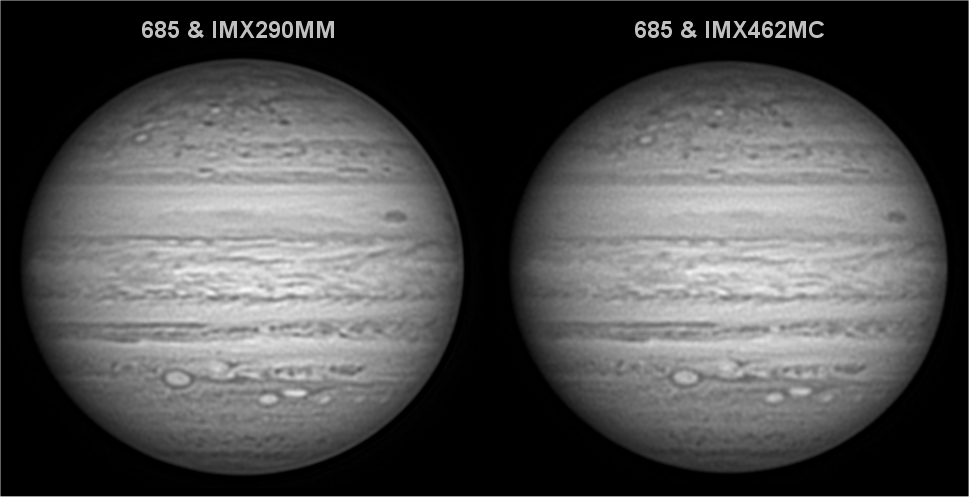
As can be seen, both images are very good, but that one taken with the IMX462 looks slightly, but definitely, less resolved than the one taken with the mono camera. Of course, this could have been the result of a less favourable seeing when using the ASI462MC, but even after viewing again the videos, this does not look to have been the case. Thanks to a trained eye about what precise details can be expected when using one filter or another, two differences quickly caught my attention:
First, the brown barge of the NEB seen at right (preceding part of the belt, North-East corner) is less contrasted with the IMX462. The comparison is difficult because the barge is setting, but although this is more subtle, the same behaviour can be observed on the faint barge at the central meridian (that one that is light orange on colour images).
Moreover, another more objective difference can be observed: the globe is less elliptical on the right image than the one the left: its equator width is smaller. This is not just a feeling, because I have carefully calculated the value of the ellipse…
On Jupiter, the precise ratio between the polar axis and the equator axis equals 0,935. This means that the polar axis measures 93,5% of the length of the equatorial axis. However, this value is going to vary in appearance following the wavelength of a given image, as phenomena of light absorption or scattering influence the result, especially in the near infrared where the spectrum of Jupiter experiences profund variations.
On the 290MM’s image, the ratio is 0,939 (in accordance with a less elliptical shape in the near IR since the equatorial limb is more absorbed than the poles).
On the 462MC’s image, the ratio increases to 0,942.
This may not seem significant, but actually it is; as an example, the less elliptical shape happens in the CH4 band when the ratio goes up to “only” 0,944 (as opposed to a certainly common perception, even in CH4 the polar axis is not larger than the equator: it is an illusion due to the strong difference of contrast between the bright poles and the extremely absorbed equatorial limb).
To my eyes the conclusion is quite clear: despite the fact that the same filter has been used, the image taken with the 462MC has recorded longer wavelengths than the 290MM. The properties of the colour sensor forces the effective passband to shift towards the infrared, and this is what explains the fainter aspect of the NEB barges, the less elliptical shape, and the slight loss of resolution, all things I have already noticed on many occasions when comparing the results (for example) between the Baader 685 filter and the Astronomik 742. But how can it be there, since the filter is the same for both cameras?
To understand we are going to focus on the particular’s response of the IMX462 sensor. As this is a colour chip, the response is not the same between the red, green and blue photosites, as can be see in the graphic below:
You have already seen this many times; I have just added a fourth curve, which is the mean sensitivity of the sensor: its value equals 2G+1R+1B (there are 2 green photosites for one red and one blue on the Bayer matrix).
The point is that the transmission of the 685 Baader starts long before the monochrome part of the sensor (after 800 nm), and that an important part of its passband happens where the mean sensitivity of the sensor (700-800 nm) is less important than on the monochrome part. Here are what the effective passbands of the filter will look like when using one camera or the other:
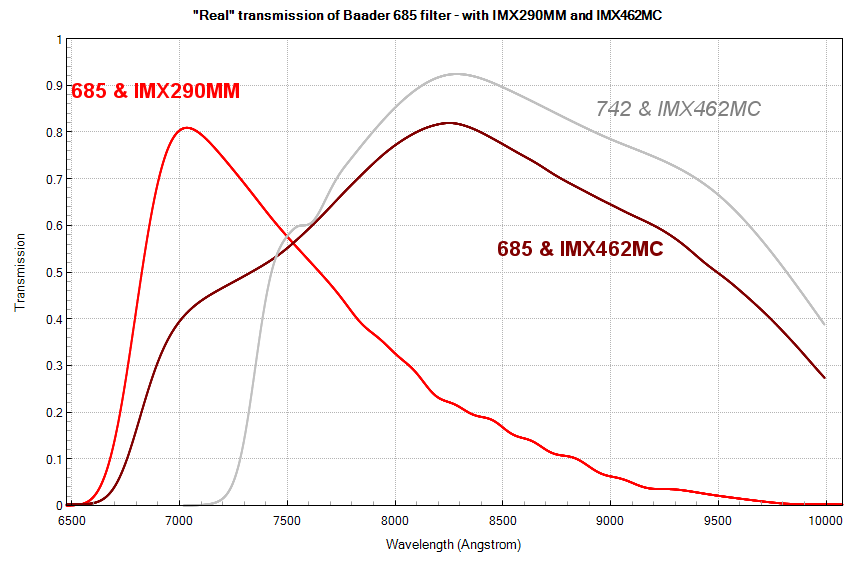
This real transmission is what will determine the real aspect of the image. We can observe that with the IMX290MM, the effective peak is around 700/720 nm. But when turning to the IMX462MC, the peak shifts around 800/850 nm, a difference of around 100 nanometers. This is significant! And well in coherence with the results obtained on the field. The effective transmission is then not that different from the one of the Astronomik 742 IR pass filter.
The IMX462 is so less efficient than a b&w one when using it with filters that transmit significantly before its monochrome part. Put more simply, the increase of resolution that one would expect when using the 685 Baader instead of any longpass 800 nm filter (those described in the first part of this study) will not be as high as it should be (but it will happen, of course!).
The gain in sensitivity is, on another hand, not that interesting either. The camera’s settings for the images above where:
– IMX290MM: expo 10 ms, gain 295, histogram 49%
– IMX462MC: expo 8 ms, gain 250, histo 41%.
We see that the b&w sensor is now again quite competitive, even more if its resolution is better!
One solution to this problem would be to forget about setting the colour balance to b&w (I will talk about this in the third part), by increasing the red gain, but there is a limit to this. In such a configuration, the red photosites will reach saturation before the others, leading to weird effects on the image, that will not be globally saturated, but that will show some strangely burnt parts here and there.
On my side I have decided to stop using the following filters with my ASI462MC: Astronomik BP642, Baader RG610 and IR685. The first filter that I plan to use is the Astronomik 742, which comes closer to the monochrome part, and for which the pros and cons balance will be more favourable.
Of course if you don’t own a mono sensor, nothing should stop you to use the other filters! You just have to know how exactly set the camera and process the image – this will be for the third part.
To be continued: the setting of the IMX462-based cameras for IR planetay imaging.

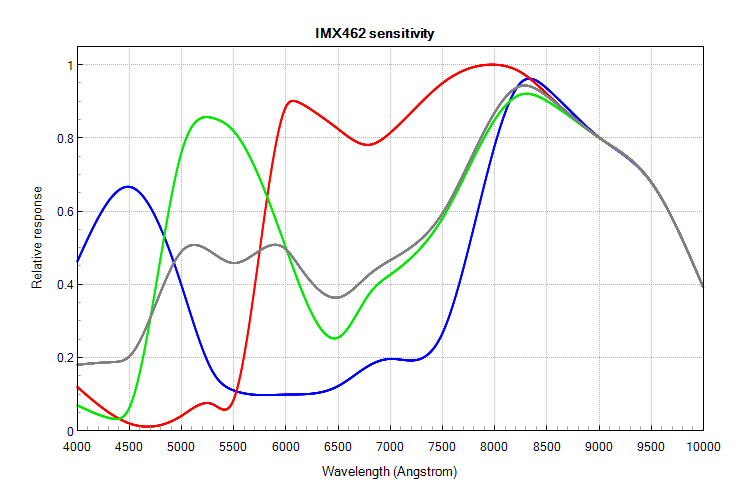
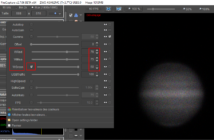
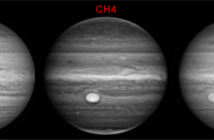
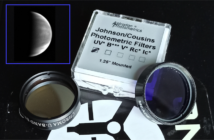
6 Comments
Hello !
For the moon certainly not, except if you want to detect subtil albedo variations (why not) but otherwise the loss of resolution will be quite disappointing. On Saturn it will be more interesting – the spectrum of the planet is the same as Jupiter – but there is less information to get through the CH4 band because the atmosphere is more thick, and the details smaller. To the least, deep IR filters such as 850, z’ and 807 are going to help a lot when seeing is not very good.
Thanks for parts 1 and 2!
Is there anything interesting about the Moon of Saturn in the wavelengths from 800 to 1000 nm?
Many thanks Anthony :)
Great work Chris! Thanks for sharing your images, measurements and experiences with the 462!
Thanks Almir, the same should apply for Uranus and Neptune. Actually I did a test on Neptune on September 22nd and to my eyes the resolution is again better with the 290 ; the histogram was none the less better with the 462. It’s difficult to make comparisons on such a tiny target. It would have been more interesting on Uranus.
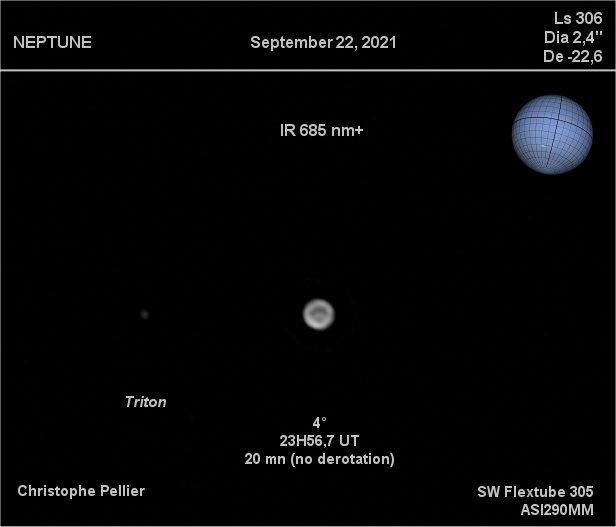
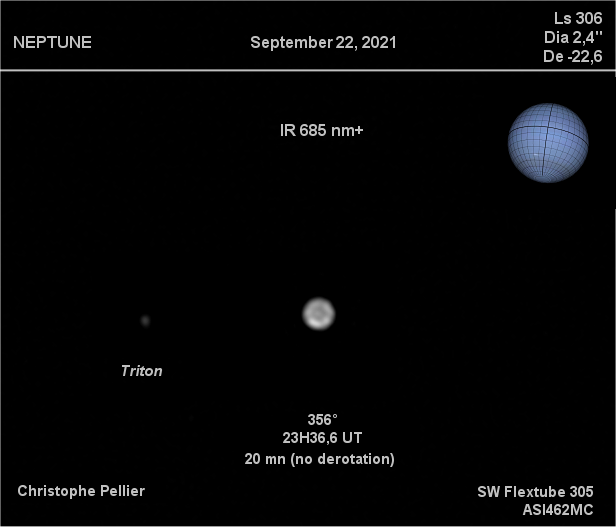
Excellent exposition, as always!
What about imaging more extreme IR targets, like Uranus and Neptune? Will the same apply?
Another question: Gold for mirror surfaces, is it worth a try?
Best regards from Brazil!
Almir Germano